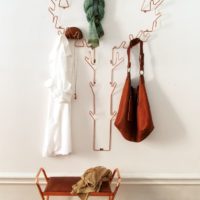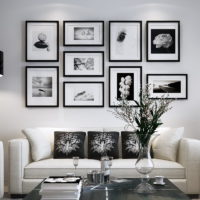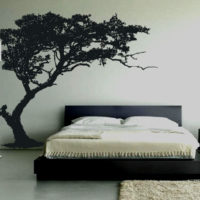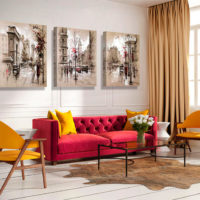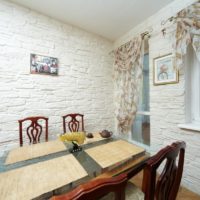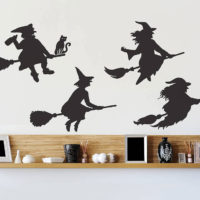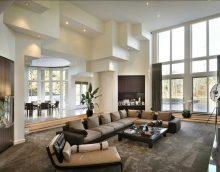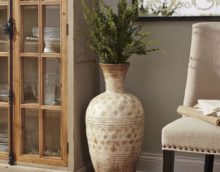What you need to know about wall design
The appearance of the interior is changing dramatically, you just have to redo the background. Do-it-yourself wall design is much easier than buying new furniture, and does not require significant investment.

The walls make the room beautiful, comfortable and functional.
Content
Wall Coating Types
You have to think carefully about which finish is suitable, since it will occupy a significant area. Coatings for wall decoration are divided into several types of different materials:
- wallpaper;
- staining;
- plaster;
- tile and stone;
- plastic and wood panels.

Coatings can be combined with each other. The photo shows an example of creating an accent from panels on the background of painted walls
Wallpaper
Wallpaper are of the following types:
- paper;
- tissue;
- vinyl;
- non-woven;
- acrylic;
- natural.

Wallpapers hide minor defects and easily stick on their own
The cheapest of them are paper. Cons: difficult to clean, stains remain. Wallpaper fade, animals tear off their claws. Pros: tearing and changing the wallpaper is easy. You can stick it yourself without experience so that it looks decent. A good option when the walls are completely tired or the old coating has deteriorated.

Wall-paper allows to imitate any finishing material with the minimum expenses
Vinyl and non-woven wallpaper are thicker, have two layers. They can be washed and painted, they are moisture resistant, but unsafe. Due to the air tightness, fungus can start, and the paint for them contains harmful compounds of zinc and copper. Good wallpaper made of natural materials can fly into a pretty penny.
Paint
A more economical and faster option is staining. No joints, no need to knead glue, align in a pattern, smooth out from bubbles. It is easy to apply, in contrast to decorative plaster. But you have to work on leveling the walls, because the paint will not hide the bumps, all the flaws, dents, cracks will be visible. If you want a uniform coating, think about liquid wallpaper, they will hide minor defects.

The color of the painting should be liked by all family members, you can use several shades, dividing the wall into parts and paint them in contrasting tones
Types of paints for walls:
- emulsion;
- acrylic;
- latex;
- oil;
- enamel;
- casein and others.

To give expressiveness to painted walls, moldings can be used. For example, make an additional line of the ceiling baguette or divide the walls into squares and rectangles
Putty
Ready-made textured mixtures of putty materials are not cheap. Decorative wall plaster from ordinary putty will suit you if you want to create a structural surface inexpensively and practically. You will need tools for creating relief: textured rollers, horn sponges, stamps.

Decorative putty will smooth out irregularities and will look unique if you create your own original patterns with a spatula
Future cracks and damage can be easily repaired. Important: if you started decorating the walls, you will have to finish the room completely, at a break in work, the joint will be noticeable.

Decorative plaster can transform any wall beyond recognition
For plaster use the following materials:
- cement;
- gypsum;
- acrylic.

A solution with decorative properties is used to create a variety of interior elements.
A rock
Wall decoration with natural stone has several advantages. The stone does not cause allergies, lasts for decades, is easy to clean and looks luxurious. It is expensive, but it is not necessary to clad the entire room. Stone panels or the design of one wall will become a stylish element of interior design.
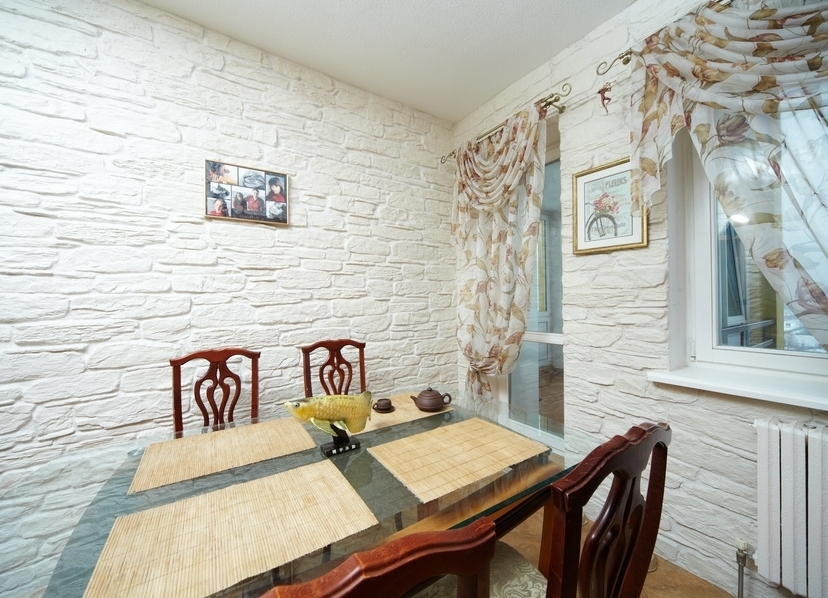
You can lay out the entire wall with a stone or create a combined design in combination with wallpaper, wood or glass
Natural stone options for designer finishes:
- marble;
- onyx;
- granite;
- travertine;
- jade;
- dolomite.

Stone is an ideal element for highlighting zones or individual objects
Tree
From natural materials it is worth highlighting a tree. Wood wall decoration is also available with a small budget. Lining or board is suitable for the Scandinavian style, panels of oak and other breeds are useful for creating modern classics. Saws and small bars can be functional or decorative elements of the walls.

The tree will add to the interior of the room a sense of unity with nature
Among the popular breeds:
- Pine;
- spruce;
- Karelian birch;
- ash;
- maple;
- oak;
- Cherry tree;
- exotic breeds.

Wood wall decoration is popular in eco style, where natural materials come first
Pictures as part of the interior
You have chosen and pasted the wallpaper, applied the paint, coating of plaster or other material. The design of the walls lacks variety. What are the design ideas?
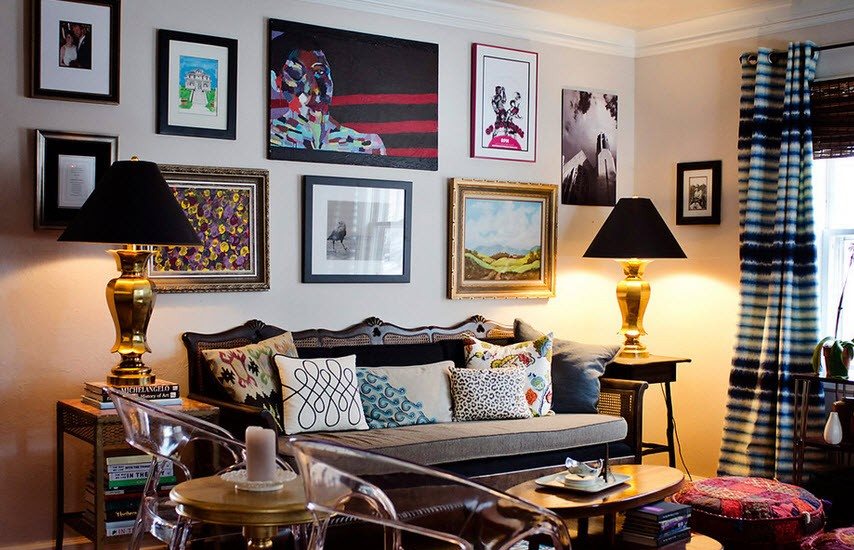
The combination of different paintings on the wall
The easiest way: to hang a picture. There are nuances. Often people hang an artwork on the wall, not thinking about whether the canvas is in harmony with the interior. The problem may not be in the colors or plot, but in the frame. The picture can be entered into the look of the room easily, but do not take for it a gilded frame with a cheap coating or too patterned. In rare cases, stylized interiors will tolerate this.

If there is no money for a personal collection of works of art, a picture can be selected “for the spot”. This is a very appropriate way out for the overall composition of the interior, and changing it later will be easier when you want to change the mood
Leave modules of four paintings with faceless photographs of flowers, buildings from a height and animals to the shops that sell them. They look boring and suitable only for decorating the same faceless interior decoration on a pseudo-designer site. Find a painting you like, it is not necessarily expensive - unknown artists sell their work for a couple of thousand. You can wander around flea markets, look for a canvas with a story. Antiquities will bring liveliness to the decoration of the walls of your room.

Now in fashion paintings in the form of photographs enlarged several times the colors
Do not strive to choose the style and colors so that they exactly fit the interior, let the picture create dynamics in the room. Vivid impressionism will dilute the gray-white-beige color scheme, and romanticism will fit even if you have austere furniture without unnecessary details and the room is designed purely functional.

An exclusive canvas or design panel can be the accent of any living space
Collages are good too. Compositions from old newspapers, your photographs or improvised materials will look stylish and give the room coziness.

Photos enliven the atmosphere of the house, bring comfort and create a unique style without any alterations
A non-standard solution is a painting on the wall, or art painting, the idea of which can be realized together with the artist-performer. This option is suitable when you are not inclined to frequent changes or treat painting only as an element of decor and you will not be sorry to get rid of a boring picture.
Decorative elements for walls
Do not want complex art? Try creating a beautiful wall decoration with simpler elements using a stencil.One and two-color patterns can be easily done with your own hands, you only need to buy a stencil from plastic or film or make it at home. Unambiguous recommendations on its location can not be given, it will show you a sense of beauty. It is very simple to work with a self-adhesive film that does not leave marks on the wall during separation. If the stencil allows, it is easier to do all the work with a roller and not mess with the brush. There are also special forms in order to apply a putty pattern and create volume.

We think over the future ornament and stick tape

We cover the patterns with water-based paint, combining the colors

After the paint dries, remove the scotch tape and admire our creation
The option of interesting wall decoration can be even simpler: choose a sticker, buy, stick, and forget. Black stickers look great on a light or white background. As a rule, trees, flowers, various toons are popular. The simplest elements of the zentangle are good. It is desirable that the background is monophonic and the patterns on the wallpaper do not swear with a sticker.

Stickers save time and money, and their diversity allows you to choose a drawing to your liking
For lovers of refinements, voluminous details for walls made of gypsum and other materials are suitable: monograms and patterns. These elements are used to create a luxurious and artsy interior. Decorating with embossed patterns should really be luxurious, but in moderation - there is no need for the expensive to be flashy. Otherwise, it will look like the situation in the houses of gypsy barons or a room in a cheap hotel.

If nothing is planned to be placed along the wall, the space can be decorated with volumetric decorative elements
Use pompous stucco is worth it if ironically beat. You can order an original ornament from the master. Ordinary flowers and birds will look stylish if you do not go too far with volumes under the antique sculptor. You can attach an element without reliefs to the wall.
Habitual as original, old as new
A beautiful element of decor can even be ... a hanger. Simple hanger with hooks for outerwear or other clothing. A base is attached to the wall, which is often found in the form of flat tree branches with ordinary hooks. Ideas are the most eccentric: bicycle handlebars, antlers, plumbing taps. A simple rough board as a basis will give the entrance hall a shade of primitiveness and naturalness. Experiment with a hanger for the kitchen: what to hang spatulas and tongs for?

Original coat hanger
Did you find the old tulle in the bins? If there is a lot of fabric and it looks decent, not torn, it can be used for interior wall design. It is not necessary to hang the tulle only on the window. If you want to decorate the bedroom with your own Provence style, you can make a small canopy on the wall. Make a curtain for an open cabinet or shelves, but think about whether it will interfere there.

An interesting idea for decorating walls in the attic
You can remake the design of the walls yourself, without resorting to the services of masters. Designer wall decoration requires not only skillful hands, but also originality. Give free rein to your imagination, and boldly decorate your home!
Video on how to choose compatible colors for walls

